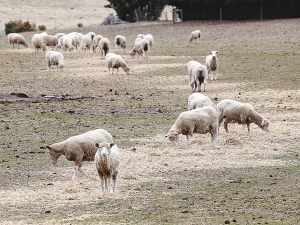Early drought fears ease in Hawke’s Bay, but caution remains
Fears of a serious early drought in Hawke’s Bay have been allayed – for the moment at least.
 Nitrate poisoning is a real risk following drought with rain encouraging sudden and rapid plant growth.
Nitrate poisoning is a real risk following drought with rain encouraging sudden and rapid plant growth.
Cases of nitrate poisoning are being reported in the Hawke’s Bay region after recent rain.
Ginny Dodunski of Total Vets provides a summary for Beef+Lamb NZ on this often fatal condition.
Why is the risk higher after drought?
Drought conditions allow a build-up of nitrate in and around roots of the plant. When followed by a significant rain event we get a sudden uptake of nutrients and rapid plant growth.
The warm and overcast weather that accompanies these good growing conditions limits photosynthesis, and plants are unable to convert nitrates into protein. Forage crops, especially cereals, and autumn-sown new pastures are the top candidates for this phenomenon.
How does it happen?
Ingested plant nitrates get changed to nitrite in the rumen. This is rapidly absorbed into the bloodstream where nitrite binds with haemoglobin on the red blood cells and prevents them from doing their job of carrying oxygen to the tissues.
Animals become oxygen starved and without prompt treatment can die. Your vet can race out and administer an antidote I/V, but prevention is far preferable!
Cattle are the most susceptible, especially pregnant cattle. Pregnant ewes are more susceptible than lambs but be aware that in bad years lambs can go down with it too.
What might you see?
Rapid breathing, weakness, tremors and imbalance are the first signs. Animals often look ‘drunk’ in the early stages.
As the condition progresses, animals salivate and froth at the mouth, and then start to gasp for breath and go down. But the progression of these signs can be so fast that all you find is dead animals. Animals can ingest enough toxic feed in one hour to start showing signs.
How do I minimise the risk of nitrate poisoning?
Test any feed that may be a risk.
Don’t ring your vet or agronomist and ask if your crop/grass is risky, they can’t tell over the phone!
Most rural vet clinics will have a nitrate dipstick test available that they can run in-clinic. Levels under 50mg/L are safe to feed, 50-100 is safe to feed with some provisos, over 100 is dangerous, but levels run up to 500mg/L – ask for the exact number.
Others may send your samples to the laboratory; if this is the case for you – ensure to request a QUANTITATIVE nitrate test. This gives the exact percentage of nitrate in the crop: 2% is dangerous, but 5% is far more dangerous.
Be aware that nitrate levels may vary across a paddock, so sample small amounts from many spots. A whole feed bag full of feed is not necessary – half a bread bag of grass or oats is plenty.
For brassica crops it is helpful to test the leaf and stem separately – so don’t just submit leaf. Bring in small chopped bits from across the paddock rather than a great big bag of whole plants. Pop samples in refrigerator if not bringing it in for testing immediately.
Be aware that high nitrate crops can take many weeks to drop. Keep checking them at 7-day intervals. Crops at the 500mg/L level may take six weeks or more to fall into the safe range.
Can I feed off a high nitrate crop?
The answer to this is ‘maybe’.
Get good advice and have a clear plan that everyone understands, if you intend to take this risk. The guidelines above are there for a reason and you take this risk at your own responsibility.
This is where it’s important to know the exact nitrate level. Any access to feed at 500mg/L is probably too much of a risk, whereas extremely careful access to feed at 100mg/L may be lower risk.
Crops in the 1-2% range or at the 100mg/L level may be able to be fed off in a limited way. Remember the one hour rule above.
Stay close and don’t allow more than one hour of access at first (20 to 30 minutes is much safer), small breaks, and strong power going through your fence are all good rules.
Put animals onto their break with full tummies (feed out baleage or hay first), and if possible, also a good source of high carbohydrate/energy food, to enable rumen bacteria to work at full speed. Graze in the afternoon when the crop has had maximum exposure to sunlight, which may help drop the nitrate levels.
However, hopefully by testing you will be able identify the sources of feed on your farm that you’re able to safely feed now, while you wait for the nitrate levels in others to drop.
• For more information: www.beeflambnz.com/knowledge-hub
Legal controls on the movement of fruits and vegetables are now in place in Auckland’s Mt Roskill suburb, says Biosecurity New Zealand Commissioner North Mike Inglis.
Arable growers worried that some weeds in their crops may have developed herbicide resistance can now get the suspected plants tested for free.
Fruit growers and exporters are worried following the discovery of a male Queensland fruit fly in Auckland this week.
Dairy prices have jumped in the overnight Global Dairy Trade (GDT) auction, breaking a five-month negative streak.
Alliance Group chief executive Willie Wiese is leaving the company after three years in the role.
A booklet produced in 2025 by the Rotoiti 15 trust, Department of Conservation and Scion – now part of the Bioeconomy Science Institute – aims to help people identify insect pests and diseases.

OPINION: The release of the Natural Environment Bill and Planning Bill to replace the Resource Management Act is a red-letter day…
OPINION: Federated Farmers has launched a new campaign, swapping ‘The Twelve Days of Christmas’ for ‘The Twelve Pests of Christmas’ to…